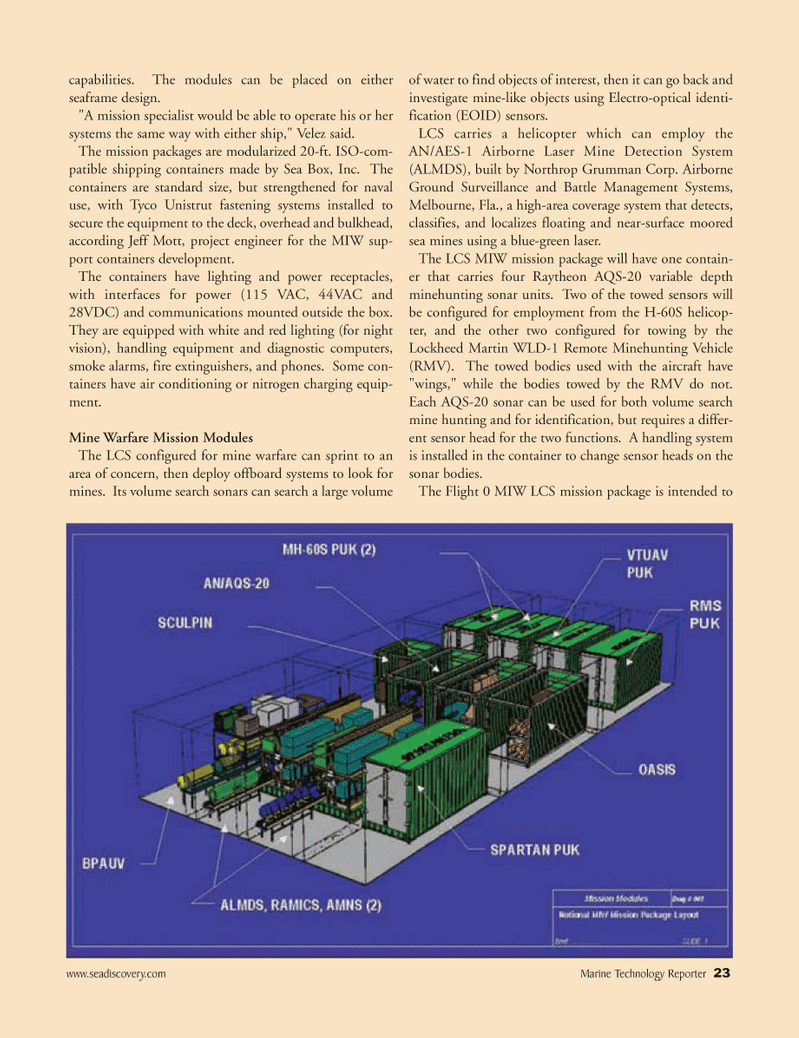
Page 23: of Marine Technology Magazine (July 2006)
Underwater Defense: Port & Harbor Security
Read this page in Pdf, Flash or Html5 edition of July 2006 Marine Technology Magazine
www.seadiscovery.com Marine Technology Reporter 23 capabilities. The modules can be placed on either seaframe design. "A mission specialist would be able to operate his or her systems the same way with either ship," Velez said.
The mission packages are modularized 20-ft. ISO-com- patible shipping containers made by Sea Box, Inc. The containers are standard size, but strengthened for naval use, with Tyco Unistrut fastening systems installed to secure the equipment to the deck, overhead and bulkhead, according Jeff Mott, project engineer for the MIW sup- port containers development.
The containers have lighting and power receptacles, with interfaces for power (115 VAC, 44VAC and 28VDC) and communications mounted outside the box.
They are equipped with white and red lighting (for night vision), handling equipment and diagnostic computers, smoke alarms, fire extinguishers, and phones. Some con- tainers have air conditioning or nitrogen charging equip- ment.
Mine Warfare Mission Modules
The LCS configured for mine warfare can sprint to an area of concern, then deploy offboard systems to look for mines. Its volume search sonars can search a large volume of water to find objects of interest, then it can go back and investigate mine-like objects using Electro-optical identi- fication (EOID) sensors.
LCS carries a helicopter which can employ the
AN/AES-1 Airborne Laser Mine Detection System (ALMDS), built by Northrop Grumman Corp. Airborne
Ground Surveillance and Battle Management Systems,
Melbourne, Fla., a high-area coverage system that detects, classifies, and localizes floating and near-surface moored sea mines using a blue-green laser.
The LCS MIW mission package will have one contain- er that carries four Raytheon AQS-20 variable depth minehunting sonar units. Two of the towed sensors will be configured for employment from the H-60S helicop- ter, and the other two configured for towing by the
Lockheed Martin WLD-1 Remote Minehunting Vehicle (RMV). The towed bodies used with the aircraft have "wings," while the bodies towed by the RMV do not.
Each AQS-20 sonar can be used for both volume search mine hunting and for identification, but requires a differ- ent sensor head for the two functions. A handling system is installed in the container to change sensor heads on the sonar bodies.
The Flight 0 MIW LCS mission package is intended to
MTR#6 (17-32).qxd 7/11/2006 8:48 AM Page 23

 22
22

 24
24
